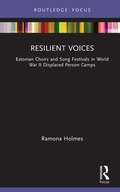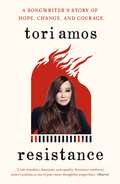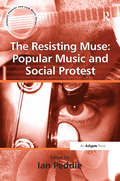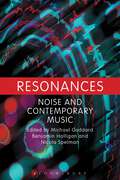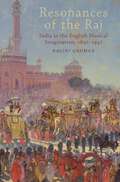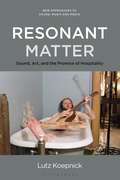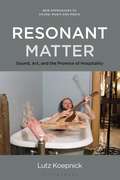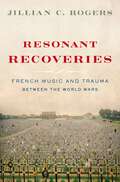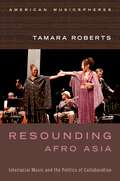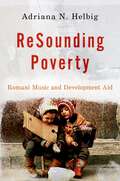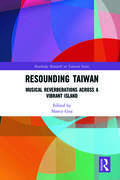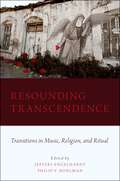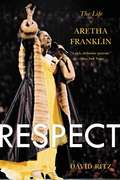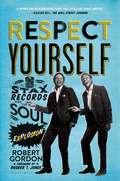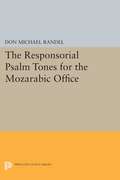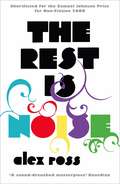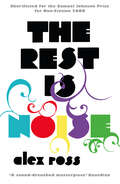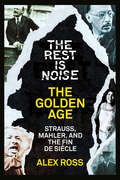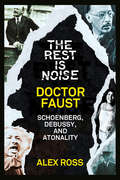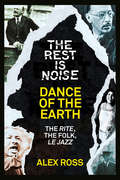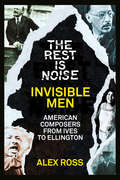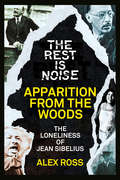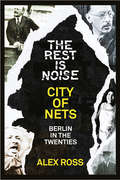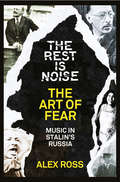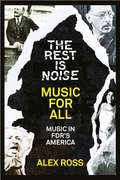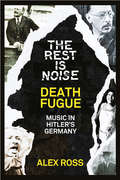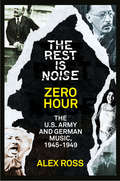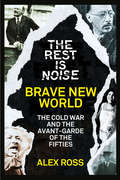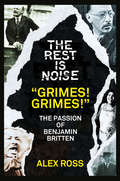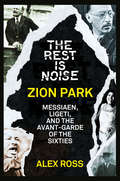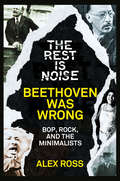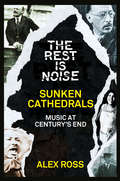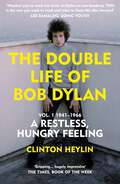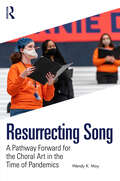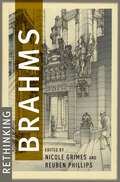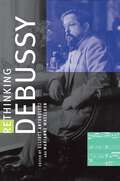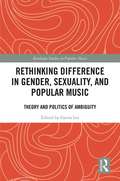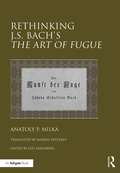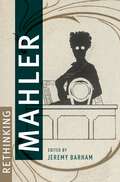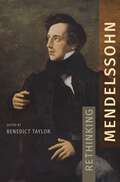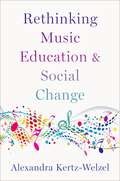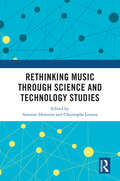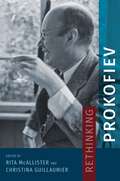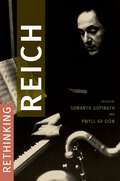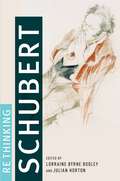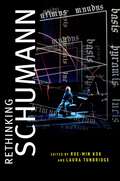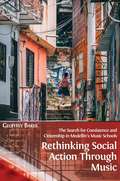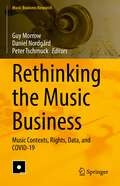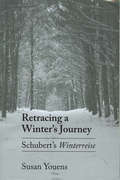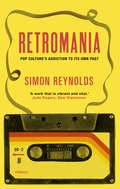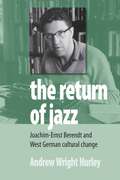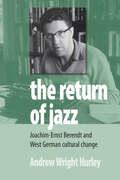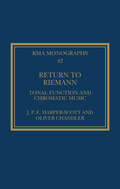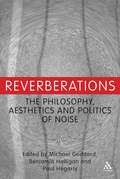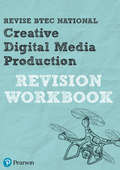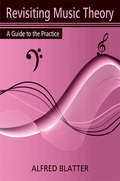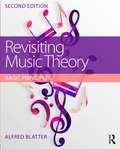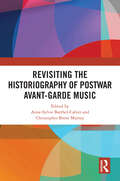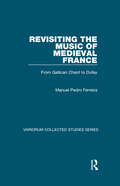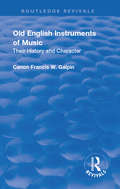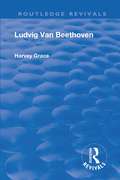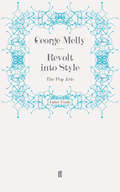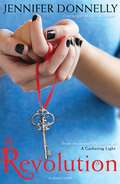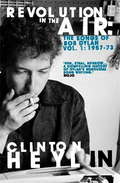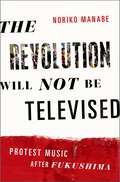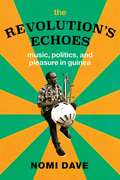Resilient Voices: Estonian Choirs and Song Festivals in World War II Displaced Person Camps
by Ramona HolmesThe aftermath of World War II sent thousands of Estonian refugees into Europe. The years of Estonian independence (1917-1940) had given them a taste of freedom and so relocation to displaced person (DP) camps in post-war Germany was extremely painful. One way in which Estonians dealt with the chaos and trauma of WWII and its aftermath was through choral singing. Just as song festivals helped establish national identity in 1869, song festivals promoted cultural cohesiveness for Estonians in WWII displaced person camps. A key turning point in hope for the Estonian DPs was the 1947 Augsburg Song Festival, which is the center point of this book. As Estonian DPs dispersed to Australia, Canada, Europe, and the United States these choirs and song festivals gave Estonians the resilience to retain their identity and to thrive in their new homes. This history of Estonian WWII DP camp choirs and song festivals is gathered from the stories of many courageous individuals and filled with the tenacious spirit of the Estonian singing culture. This work contributes to an understanding of immigration, identity, and resilience and is particularly important within the field of music regarding music and healing, music and identity, historical musicology, ethnomusicology, and music and politics.
Resistance: A Songwriter’s Story of Hope, Change and Courage
by Tori AmosSince the release of her first, career-defining solo album Little Earthquakes, Tori Amos has been one of the music industry's most enduring and ingenious artists. From her unnerving depiction of sexual assault in "Me and a Gun" to her post-9/11 album Scarlet's Walk to her latest album Native Invader, her work has never shied away from intermingling the personal with the political. Amos began playing piano as a teenager for the politically powerful at hotel bars in Washington, D.C., during the formative years of the post-Goldwater and then Koch-led Libertarian and Reaganite movements. The story continues to her time as a hungry artist in L.A. to the subsequent three decades of her formidable music career. Amos explains how she managed to create meaningful, politically resonant work against patriarchal power structures-and how her proud declarations of feminism and her fight for the marginalized always proved to be her guiding light. She teaches readers to engage with intention in this tumultuous global climate and speaks directly to supporters of #MeToo and #TimesUp, as well as young people fighting for their rights and visibility in the world. Filled with compassionate guidance and actionable advice-and using some of the most powerful, political songs in Amos's canon-this book is for readers determined to steer the world back in the right direction.
The Resisting Muse: Popular Music and Social Protest (Ashgate Popular and Folk Music Series)
by Ian PeddiePopular music has traditionally served as a rallying point for voices of opposition, across a huge variety of genres. This volume examines the various ways popular music has been deployed as anti-establishment and how such opposition both influences and responds to the music produced. Implicit in the notion of resistance is a broad adversarial hegemony against which opposition is measured. But it would be wrong to regard the music of popular protest as a kind of dialogue in league against 'the establishment'. Convenient though they are, such 'us and them' arguments bespeak a rather shop-worn stance redolent of youthful rebellion. It is much more fruitful to perceive the relationship as a complex dialectic where musical protest is as fluid as the audiences to which it appeals and the hegemonic structures it opposes. The book's contemporary focus (largely post-1975) allows for comprehensive coverage of extremely diverse forms of popular music in relation to the creation of communities of protest. Because such communities are fragmented and diverse, the shared experience and identity popular music purports is dependent upon an audience collectivity that is now difficult to presume. In this respect, The Resisting Muse examines how the forms and aims of social protest music are contingent upon the audience's ability to invest the music with the 'appropriate' political meaning. Amongst a plethora of artists, genres, and themes, highlights include discussions of Aboriginal rights and music, Bauhaus, Black Sabbath, Billy Bragg, Bono, Cassette culture, The Capitol Steps, Class, The Cure , DJ Spooky, Drum and Bass, Eminem, Farm Aid, Foxy Brown, Folk, Goldie, Gothicism, Woody Guthrie, Heavy Metal, Hip-hop, Independent/home publishing, Iron Maiden, Joy Division, Jungle, Led Zeppelin, Lil'Kim, Live Aid, Marilyn Manson, Bob Marley, MC Eiht, Minor Threat, Motown, Queen Latifah, Race, Rap, Rastafarianism, Reggae, The Roots, Diana Ross, Rush, Salt-n-Pepa, 7 Seconds, Roxanne Shanté, Siouxsie and the Banshees, The Sisters of Mercy, Michelle Shocked, Bessie Smith, Straight edge Sunrize Band, Bunny Wailer, Wilco, Bart Willoughby, Wirrinyga Band, Zines.
The Resisting Muse: Popular Music and Social Protest (Ashgate Popular and Folk Music Series)
by Ian PeddiePopular music has traditionally served as a rallying point for voices of opposition, across a huge variety of genres. This volume examines the various ways popular music has been deployed as anti-establishment and how such opposition both influences and responds to the music produced. Implicit in the notion of resistance is a broad adversarial hegemony against which opposition is measured. But it would be wrong to regard the music of popular protest as a kind of dialogue in league against 'the establishment'. Convenient though they are, such 'us and them' arguments bespeak a rather shop-worn stance redolent of youthful rebellion. It is much more fruitful to perceive the relationship as a complex dialectic where musical protest is as fluid as the audiences to which it appeals and the hegemonic structures it opposes. The book's contemporary focus (largely post-1975) allows for comprehensive coverage of extremely diverse forms of popular music in relation to the creation of communities of protest. Because such communities are fragmented and diverse, the shared experience and identity popular music purports is dependent upon an audience collectivity that is now difficult to presume. In this respect, The Resisting Muse examines how the forms and aims of social protest music are contingent upon the audience's ability to invest the music with the 'appropriate' political meaning. Amongst a plethora of artists, genres, and themes, highlights include discussions of Aboriginal rights and music, Bauhaus, Black Sabbath, Billy Bragg, Bono, Cassette culture, The Capitol Steps, Class, The Cure , DJ Spooky, Drum and Bass, Eminem, Farm Aid, Foxy Brown, Folk, Goldie, Gothicism, Woody Guthrie, Heavy Metal, Hip-hop, Independent/home publishing, Iron Maiden, Joy Division, Jungle, Led Zeppelin, Lil'Kim, Live Aid, Marilyn Manson, Bob Marley, MC Eiht, Minor Threat, Motown, Queen Latifah, Race, Rap, Rastafarianism, Reggae, The Roots, Diana Ross, Rush, Salt-n-Pepa, 7 Seconds, Roxanne Shanté, Siouxsie and the Banshees, The Sisters of Mercy, Michelle Shocked, Bessie Smith, Straight edge Sunrize Band, Bunny Wailer, Wilco, Bart Willoughby, Wirrinyga Band, Zines.
Resonances: Noise and Contemporary Music
by Michael Goddard Benjamin Halligan Nicola SpelmanResonances is a compelling collection of new essays by scholars, writers and musicians, all seeking to explore and enlighten this field of study. Noise seems to stand for a lack of aesthetic grace, to alienate or distract rather than enrapture. And yet the drones of psychedelia, the racket of garage rock and punk, the thudding of rave, the feedback of shoegaze and post-rock, the bombast of thrash and metal, the clatter of jungle and the stuttering of electronica, together with notable examples of avant-garde noise art, have all found a place in the history of contemporary musics, and are recognised as representing key evolutionary moments. Noise therefore is the untold story of contemporary popular music, and in a critical exploration of noise lies the possibility of a new narrative: one that is wide-ranging, connects the popular to the underground and avant-garde, fully posits the studio as a musical instrument, and demands new critical and theoretical paradigms of those seeking to write about music.
Resonances: Noise and Contemporary Music
by Michael Goddard Benjamin Halligan Nicola SpelmanResonances is a compelling collection of new essays by scholars, writers and musicians, all seeking to explore and enlighten this field of study. Noise seems to stand for a lack of aesthetic grace, to alienate or distract rather than enrapture. And yet the drones of psychedelia, the racket of garage rock and punk, the thudding of rave, the feedback of shoegaze and post-rock, the bombast of thrash and metal, the clatter of jungle and the stuttering of electronica, together with notable examples of avant-garde noise art, have all found a place in the history of contemporary musics, and are recognised as representing key evolutionary moments. Noise therefore is the untold story of contemporary popular music, and in a critical exploration of noise lies the possibility of a new narrative: one that is wide-ranging, connects the popular to the underground and avant-garde, fully posits the studio as a musical instrument, and demands new critical and theoretical paradigms of those seeking to write about music.
Resonances of the Raj: India in the English Musical Imagination,1897-1947
by Nalini GhumanDuring the century of British rule of the Indian subcontinent known as the British Raj, the rulers felt the significant influence of their exotic subjects. Resonances of the Raj examines the ramifications of the intertwined and overlapping histories of Britain and India on English music in the last fifty years of the colonial encounter, and traces the effects of the Raj on the English musical imagination. Conventional narratives depict a one-way influence of Britain on India, with the 'discovery' of Indian classical music occurring only in the post-colonial era. Drawing on new archival sources and approaches in cultural studies, author Nalini Ghuman shows that on the contrary, England was both deeply aware of and heavily influenced by India musically during the Indian-British colonial encounter. Case studies of representative figures, including composers Edward Elgar and Gustav Holst, and Maud MacCarthy, an ethnomusicologist and performer of the era, integrate music directly into the cultural history of the British Raj. Ghuman thus reveals unexpected minglings of peoples, musics and ideas that raise questions about 'Englishness', the nature of Empire, and the fixedness of identity. Richly illustrated with analytical music examples and archival photographs and documents, many of which appear here in print for the first time, Resonances of the Raj brings fresh hearings to both familiar and little-known musics of the time, and reveals a rich and complex history of cross-cultural musical imaginings which leads to a reappraisal of the accepted historiographies of both British musical culture and of Indo-Western fusion.
Resonant Matter: Sound, Art, and the Promise of Hospitality (New Approaches to Sound, Music, and Media)
by Lutz KoepnickIn Resonant Matter, Lutz Koepnick considers contemporary sound and installation art as a unique laboratory of hospitality amid inhospitable times. Inspired by Ragnar Kjartansson's nine-channel video installation The Visitors (2012), the book explores resonance-the ability of objects to be affected by the vibrations of other objects-as a model of art's fleeting promise to make us coexist with things strange and other. In a series of nuanced readings, Koepnick follows the echoes of distant, unexpected, and unheard sounds in twenty-first century art to reflect on the attachments we pursue to sustain our lives and the walls we need to tear down to secure possible futures. The book's nine chapters approach The Visitors from ever-different conceptual angles while bringing it into dialogue with the work of other artists and musicians such as Lawrence Abu Hamdan, Guillermo Galindo, Mischa Kuball, Philipp Lachenmann, Alvien Lucier, Teresa Margolles, Carsten Nicolai, Camille Norment, Susan Philipsz, David Rothenberg, Juliana Snapper, and Tanya Tagaq. With this book, Koepnick situates resonance as a vital concept of contemporary art criticism and sound studies. His analysis encourages us not only to expand our understanding of the role of sound in art, of sound art, but to attune our critical encounter with art to art's own resonant thinking.
Resonant Matter: Sound, Art, and the Promise of Hospitality (New Approaches to Sound, Music, and Media)
by Lutz KoepnickIn Resonant Matter, Lutz Koepnick considers contemporary sound and installation art as a unique laboratory of hospitality amid inhospitable times. Inspired by Ragnar Kjartansson's nine-channel video installation The Visitors (2012), the book explores resonance-the ability of objects to be affected by the vibrations of other objects-as a model of art's fleeting promise to make us coexist with things strange and other. In a series of nuanced readings, Koepnick follows the echoes of distant, unexpected, and unheard sounds in twenty-first century art to reflect on the attachments we pursue to sustain our lives and the walls we need to tear down to secure possible futures. The book's nine chapters approach The Visitors from ever-different conceptual angles while bringing it into dialogue with the work of other artists and musicians such as Lawrence Abu Hamdan, Guillermo Galindo, Mischa Kuball, Philipp Lachenmann, Alvien Lucier, Teresa Margolles, Carsten Nicolai, Camille Norment, Susan Philipsz, David Rothenberg, Juliana Snapper, and Tanya Tagaq. With this book, Koepnick situates resonance as a vital concept of contemporary art criticism and sound studies. His analysis encourages us not only to expand our understanding of the role of sound in art, of sound art, but to attune our critical encounter with art to art's own resonant thinking.
Resonant Recoveries: French Music and Trauma Between the World Wars
by Jillian C. RogersCoping with trauma and the losses of World War I was a central concern for French musicians in the interwar period. Almost all of them were deeply affected by the war as they fought in the trenches, worked in military hospitals, or mourned a friend or relative who had been wounded, killed, or taken prisoner. In Resonant Recoveries, author Jillian C. Rogers argues that French modernist composers processed this experience of unprecedented violence by turning their musical activities into locations for managing and performing trauma. Through analyses of archival materials, French medical, philosophical, and literary texts, and the music produced between the wars, Rogers frames World War I as a pivotal moment in the history of music therapy. When musicians and their audiences used music to remember lost loved ones, perform grief, create healing bonds of friendship, and find consolation in soothing sonic vibrations and rhythmic bodily movements, they reconfigured music into an embodied means of consolation--a healer of wounded minds and bodies. This in-depth account of the profound impact that postwar trauma had on French musical life makes a powerful case for the importance of addressing trauma, mourning, and people's emotional lives in music scholarship. This is an open access title available under the terms of a CC BY-NC-ND 4.0 licence. It is free to read at Oxford Scholarship Online and offered as a free PDF download from OUP and selected open access locations.
Resonant Recoveries: French Music and Trauma Between the World Wars
by Jillian C. RogersCoping with trauma and the losses of World War I was a central concern for French musicians in the interwar period. Almost all of them were deeply affected by the war as they fought in the trenches, worked in military hospitals, or mourned a friend or relative who had been wounded, killed, or taken prisoner. In Resonant Recoveries, author Jillian C. Rogers argues that French modernist composers processed this experience of unprecedented violence by turning their musical activities into locations for managing and performing trauma. Through analyses of archival materials, French medical, philosophical, and literary texts, and the music produced between the wars, Rogers frames World War I as a pivotal moment in the history of music therapy. When musicians and their audiences used music to remember lost loved ones, perform grief, create healing bonds of friendship, and find consolation in soothing sonic vibrations and rhythmic bodily movements, they reconfigured music into an embodied means of consolation--a healer of wounded minds and bodies. This in-depth account of the profound impact that postwar trauma had on French musical life makes a powerful case for the importance of addressing trauma, mourning, and people's emotional lives in music scholarship. This is an open access title available under the terms of a CC BY-NC-ND 4.0 licence. It is free to read at Oxford Scholarship Online and offered as a free PDF download from OUP and selected open access locations.
Resounding Afro Asia: Interracial Music and the Politics of Collaboration (American Musicspheres)
by Tamara RobertsCultural hybridity is a celebrated hallmark of U.S. American music and identity. Yet hybrid music is all too often marked -and marketed - under a single racial label. Resounding Afro Asia examines music projects that counter this convention; these projects instead foreground racial mixture in players, audiences, and sound in the very face of the ghettoizing culture industry. Giving voice to four contemporary projects, author Tamara Roberts traces black/Asian engagements that reach across the United States and beyond: Funkadesi, Yoko Noge, Fred Ho and the Afro Asian Music Ensemble, and Red Baraat. From Indian funk & reggae, to Japanese folk & blues, to jazz in various Asian and African traditions, to Indian brass band and New Orleans second line, these artists live multiracial lives in which they inhabit - and yet exceed - multicultural frameworks built on essentialism and segregation. When these musicians collaborate, they generate and perform racially marked sounds that do not conform to their individual racial identities. The Afro Asian artists discussed in this book splinter the expectations of racial determinism, and through improvisation and composition, articulate new identities and subjectivities in conversation with each other. These dynamic social, aesthetic, and sonic practices construct a forum for the negotiation of racial and cultural difference and the formation of inter-minority solidarities. Resounding Afro Asia joins a growing body of literature that is writing Asian American artists back into U.S. popular music history, while highlighting interracial engagements that have fueled U.S. music making. The book will appeal to scholars of music, ethnomusicology, race theory, and politics, as well as those interested in race and popular music.
RESOUNDING AFRO ASIA AM C: Interracial Music and the Politics of Collaboration (American Musicspheres)
by Tamara RobertsCultural hybridity is a celebrated hallmark of U.S. American music and identity. Yet hybrid music is all too often marked -and marketed - under a single racial label. Resounding Afro Asia examines music projects that counter this convention; these projects instead foreground racial mixture in players, audiences, and sound in the very face of the ghettoizing culture industry. Giving voice to four contemporary projects, author Tamara Roberts traces black/Asian engagements that reach across the United States and beyond: Funkadesi, Yoko Noge, Fred Ho and the Afro Asian Music Ensemble, and Red Baraat. From Indian funk & reggae, to Japanese folk & blues, to jazz in various Asian and African traditions, to Indian brass band and New Orleans second line, these artists live multiracial lives in which they inhabit - and yet exceed - multicultural frameworks built on essentialism and segregation. When these musicians collaborate, they generate and perform racially marked sounds that do not conform to their individual racial identities. The Afro Asian artists discussed in this book splinter the expectations of racial determinism, and through improvisation and composition, articulate new identities and subjectivities in conversation with each other. These dynamic social, aesthetic, and sonic practices construct a forum for the negotiation of racial and cultural difference and the formation of inter-minority solidarities. Resounding Afro Asia joins a growing body of literature that is writing Asian American artists back into U.S. popular music history, while highlighting interracial engagements that have fueled U.S. music making. The book will appeal to scholars of music, ethnomusicology, race theory, and politics, as well as those interested in race and popular music.
ReSounding Poverty: Romani Music and Development Aid
by Adriana N. HelbigReSounding Poverty: Romani Music and Development Aid engages with global scholarship on development, poverty, and applied research. It addresses the role of non-governmental organizations (NGOs) within postsocialist neoliberal processes and analyzes the economic structures within which Romani musics circulate. Specifically, ReSounding Poverty offers a micro ethnography of economic networks that impact the daily lives of Romani musicians on the borders of the former Soviet Union and the European Union. It argues that the development aid allotted to provide economic assistance to Romani communities, when analyzed from the perspective of the performance arts, continues to marginalize the poorest among them. Through their structure and programming, NGOs choose which segments of the population are the most vulnerable and in the greatest need of assistance. Drawing on ethnographic research in development contexts, ReSounding Poverty asks who speaks for whom within the Romani rights movement today. Framing the critique of development aid in musical terms, it engages with Romani marginalization and economic deprivation through a closer listening to vocal inflections, physical vocalizations of health and disease, and emotional affect. ReSounding Poverty brings us into the back rooms of saman, mud and straw brick, houses not visited by media reporters and politicians, amplifying the cultural expressions of the Romani poor, silenced in the business of development.
ReSounding Poverty: Romani Music and Development Aid
by Adriana N. HelbigReSounding Poverty: Romani Music and Development Aid engages with global scholarship on development, poverty, and applied research. It addresses the role of non-governmental organizations (NGOs) within postsocialist neoliberal processes and analyzes the economic structures within which Romani musics circulate. Specifically, ReSounding Poverty offers a micro ethnography of economic networks that impact the daily lives of Romani musicians on the borders of the former Soviet Union and the European Union. It argues that the development aid allotted to provide economic assistance to Romani communities, when analyzed from the perspective of the performance arts, continues to marginalize the poorest among them. Through their structure and programming, NGOs choose which segments of the population are the most vulnerable and in the greatest need of assistance. Drawing on ethnographic research in development contexts, ReSounding Poverty asks who speaks for whom within the Romani rights movement today. Framing the critique of development aid in musical terms, it engages with Romani marginalization and economic deprivation through a closer listening to vocal inflections, physical vocalizations of health and disease, and emotional affect. ReSounding Poverty brings us into the back rooms of saman, mud and straw brick, houses not visited by media reporters and politicians, amplifying the cultural expressions of the Romani poor, silenced in the business of development.
Resounding Taiwan: Musical Reverberations Across a Vibrant Island (Routledge Research on Taiwan Series)
by Nancy GuyThis book vibrantly demonstrates how the study of music allows for identification and interpretation of the forces that form Taiwanese society, from politics and policy to reactions to and assertions of such policies. Contributors to this edited volume explore how music shapes life — and life shapes music — in Taiwan, focusing on subjects ranging from musical life under Japanese colonial rule (1895–1945) through to the contemporary creations of Indigenous musicians, popular music performance and production, Christian religious music, traditional ritual music and theatre, conceptions about sound and noise, and garbage truck music's role in reducing household waste. The volume’s twelve chapters present diverse approaches to their sounding subjects, some deeply rooted in the methods and concerns explored by Taiwan's first generation of ethnomusicologists. Others employ current social theories. Presenting a window into the cultural lives of the residents of this multicultural, politically contested island, Resounding Taiwan will appeal to students and scholars of musicology and ethnomusicology, anthropology and Asian studies more widely.
Resounding Taiwan: Musical Reverberations Across a Vibrant Island (Routledge Research on Taiwan Series)
by Nancy GuyThis book vibrantly demonstrates how the study of music allows for identification and interpretation of the forces that form Taiwanese society, from politics and policy to reactions to and assertions of such policies. Contributors to this edited volume explore how music shapes life — and life shapes music — in Taiwan, focusing on subjects ranging from musical life under Japanese colonial rule (1895–1945) through to the contemporary creations of Indigenous musicians, popular music performance and production, Christian religious music, traditional ritual music and theatre, conceptions about sound and noise, and garbage truck music's role in reducing household waste. The volume’s twelve chapters present diverse approaches to their sounding subjects, some deeply rooted in the methods and concerns explored by Taiwan's first generation of ethnomusicologists. Others employ current social theories. Presenting a window into the cultural lives of the residents of this multicultural, politically contested island, Resounding Taiwan will appeal to students and scholars of musicology and ethnomusicology, anthropology and Asian studies more widely.
Resounding Transcendence: Transitions in Music, Religion, and Ritual
by Jeffers Engelhardt Philip BohlmanResounding Transcendence is a pathbreaking set of ethnographic and historical essays by leading scholars exploring the ways sacred music effects cultural, political, and religious transitions in the contemporary world. With chapters covering Christian, Muslim, Jewish, and Buddhist practices in East and Southeast Asia, the Indian subcontinent, North America, the Caribbean, North Africa, and Europe, the volume establishes the theoretical and methodological foundations for music scholarship to engage in current debates about modern religion and secular epistemologies. It also transforms those debates through sophisticated, nuanced treatments of sound and music - ubiquitous elements of ritual and religion often glossed over in other disciplines. Resounding Transcendence confronts the relationship of sound, divinity, and religious practice in diverse post-secular contexts. By examining the immanence of transcendence in specific social and historical contexts and rethinking the reified nature of "religion" and "world religions," these authors examine the dynamics of difference and transition within and between sacred musical practices. The work in this volume transitions between traditional spaces of sacred musical practice and emerging public spaces for popular religious performance; between the transformative experience of ritual and the sacred musical affordances of media technologies; between the charisma of individual performers and the power of the marketplace; and between the making of authenticity and hybridity in religious repertoires and practices. Broad in scope, rich in ethnographic and historical detail, and theoretically ambitious, Resounding Transcendence is an essential contribution to the study of music and religion.
RESOUNDING TRANSCENDENCE C: Transitions in Music, Religion, and Ritual
by Jeffers Engelhardt and Philip V. BohlmanResounding Transcendence is a pathbreaking set of ethnographic and historical essays by leading scholars exploring the ways sacred music effects cultural, political, and religious transitions in the contemporary world. With chapters covering Christian, Muslim, Jewish, and Buddhist practices in East and Southeast Asia, the Indian subcontinent, North America, the Caribbean, North Africa, and Europe, the volume establishes the theoretical and methodological foundations for music scholarship to engage in current debates about modern religion and secular epistemologies. It also transforms those debates through sophisticated, nuanced treatments of sound and music - ubiquitous elements of ritual and religion often glossed over in other disciplines. Resounding Transcendence confronts the relationship of sound, divinity, and religious practice in diverse post-secular contexts. By examining the immanence of transcendence in specific social and historical contexts and rethinking the reified nature of "religion" and "world religions," these authors examine the dynamics of difference and transition within and between sacred musical practices. The work in this volume transitions between traditional spaces of sacred musical practice and emerging public spaces for popular religious performance; between the transformative experience of ritual and the sacred musical affordances of media technologies; between the charisma of individual performers and the power of the marketplace; and between the making of authenticity and hybridity in religious repertoires and practices. Broad in scope, rich in ethnographic and historical detail, and theoretically ambitious, Resounding Transcendence is an essential contribution to the study of music and religion.
Respect: The Life of Aretha Franklin
by David RitzThe definitive biography of the Queen of Soul from acclaimed music writer David Ritz. Aretha Franklin began life as the golden daughter of a progressive and promiscuous Baptist preacher. Raised without her mother, she was a gospel prodigy who gave birth to two sons in her teens and left them and her native Detroit for New York, where she struggled to find her true voice. It was not until 1967, when a white Jewish producer insisted she return to her gospel-soul roots, that fame and fortune finally came via "Respect" and a rapidfire string of hits. She has evolved ever since, amidst personal tragedy, surprise Grammy performances, and career reinventions. Again and again, Aretha stubbornly finds a way to triumph over troubles, even as they continue to build. Her hold on the crown is tenacious, and in Respect, David Ritz gives us the definitive life of one of the greatest talents in all American culture.
Respect Yourself: Stax Records and the Soul Explosion
by Robert GordonThe story of Stax Records unfolds like a Greek tragedy. A white brother and sister build a record company that becomes a monument to racial harmony in 1960's segregated south Memphis. Their success is startling, and Stax soon defines an international sound. Then, after losses both business and personal, the siblings part, and the brother allies with a visionary African-American partner. Under integrated leadership, Stax explodes as a national player until, Icarus-like, they fall from great heights to a tragic demise. Everything is lost, and the sanctuary that flourished is ripped from the ground. A generation later, Stax is rebuilt brick by brick to once again bring music and opportunity to the people of Memphis. Set in the world of 1960s and '70s soul music, Respect Yourself is a story of epic heroes in a shady industry. It's about music and musicians -- Isaac Hayes, Otis Redding, Sam and Dave, Wilson Pickett, the Staple Singers, and Booker T. and the M.G.'s, Stax's interracial house band. It's about a small independent company's struggle to survive in a business world of burgeoning conglomerates. And always at the center of the story is Memphis, Tennessee, an explosive city struggling through heated, divisive years. Told by one of our leading music chroniclers, Respect Yourself brings to life this treasured cultural institution and the city that created it.
The Responsorial Psalm Tones for the Mozarabic Office
by Don Michael RandelThis definitive study takes as its subject a group of melodies copied many times, even within single manuscripts. Professor Randel is therefore able to base his conclusions about the relationship of the manuscript sources to one another on twenty-six separate Spanish manuscripts. He shows that there were actually four distinct traditions associated with these manuscripts instead of two as formerly assumed. By comparing the four traditions, he draws new conclusions about the relative antiquity of the written tradition for these psalm tones, the presence or absence of a modal system in the Mozarabic chant, and the development of the two general types of notation.Originally published in 1969.The Princeton Legacy Library uses the latest print-on-demand technology to again make available previously out-of-print books from the distinguished backlist of Princeton University Press. These editions preserve the original texts of these important books while presenting them in durable paperback and hardcover editions. The goal of the Princeton Legacy Library is to vastly increase access to the rich scholarly heritage found in the thousands of books published by Princeton University Press since its founding in 1905.
The Rest is Noise: Listening to the Twentieth Century (PDF)
by Alex RossAlex Ross's sweeping history of twentieth-century classical music, winner of the Guardian First Book Award, is a gripping account of a musical revolution.
The Rest is Noise: Listening To The Twentieth Century (Playaway Adult Nonfiction Ser.)
by Alex RossAlex Ross’s sweeping history of twentieth-century classical music, winner of the Guardian First Book Award, is a gripping account of a musical revolution.
The Rest Is Noise Series: Strauss, Mahler, And The Fin De Siecle (Playaway Adult Nonfiction Ser.)
by Alex RossThis is a chapter from Alex Ross’s groundbreaking history of twentieth-century classical music, ‘The Rest is Noise’. Further extracts are available as digital shorts, accompanying the London Southbank festival programme.
The Rest Is Noise Series: Schoenberg, Debussy, And Atonality (Playaway Adult Nonfiction Ser.)
by Alex RossThis is a chapter from Alex Ross’s groundbreaking history of twentieth-century classical music, ‘The Rest is Noise’. Further extracts are available as digital shorts, accompanying the London Southbank festival programme.
The Rest Is Noise Series: The Rite, The Folk, Le Jazz (Playaway Adult Nonfiction Ser.)
by Alex RossThis is a chapter from Alex Ross’s groundbreaking history of twentieth-century classical music, ‘The Rest is Noise’. Further extracts are available as digital shorts, accompanying the London Southbank festival programme.
The Rest Is Noise Series: American Composers From Ives To Ellington (Playaway Adult Nonfiction Ser.)
by Alex RossThis is a chapter from Alex Ross’s groundbreaking history of twentieth-century classical music, ‘The Rest is Noise’. Further extracts are available as digital shorts, accompanying the London Southbank festival programme.
The Rest Is Noise Series: The Loneliness Of Jean Sibelius (Playaway Adult Nonfiction Ser.)
by Alex RossThis is a chapter from Alex Ross’s groundbreaking history of twentieth-century classical music, ‘The Rest is Noise’. Further extracts are available as digital shorts, accompanying the London Southbank festival programme.
The Rest Is Noise Series: Berlin In The Twenties
by Alex RossThis is a chapter taken from Alex Ross’s groundbreaking history of twentieth-century classical music, The Rest is Noise.
The Rest Is Noise Series: Music In Stalin's Russia
by Alex RossThis is a chapter taken from Alex Ross’s groundbreaking history of twentieth-century classical music, The Rest is Noise.
The Rest Is Noise Series: Music For All: Music In Fdr's America
by Alex RossThis is a chapter taken from Alex Ross’s groundbreaking history of twentieth-century classical music, The Rest is Noise.
The Rest Is Noise Series: Music In Hitler's Germany
by Alex RossThis is a chapter taken from Alex Ross’s groundbreaking history of twentieth-century classical music, The Rest is Noise.
The Rest Is Noise Series: The U. S. Army And German Music, 1945-1949
by Alex RossThis is a chapter from Alex Ross’s groundbreaking history of twentieth-century classical music, ‘The Rest is Noise’. Further extracts are available as digital shorts, accompanying the London Southbank festival programme.
The Rest Is Noise Series: The Cold War And The Avant-garde Of The Fifties
by Alex RossThis is a chapter from Alex Ross’s groundbreaking history of twentieth-century classical music, ‘The Rest is Noise’. Further extracts are available as digital shorts, accompanying the London Southbank festival programme.
The Rest Is Noise Series: The Passion Of Benjamin Britten
by Alex RossThis is a chapter from Alex Ross’s groundbreaking history of twentieth-century classical music, ‘The Rest is Noise’. Further extracts are available as digital shorts, accompanying the London Southbank festival programme.
The Rest Is Noise Series: Messiaen, Ligeti, And The Avant-garde Of The Sixties
by Alex RossThis is a chapter from Alex Ross’s groundbreaking history of twentieth-century classical music, ‘The Rest is Noise’. Further extracts are available as digital shorts, accompanying the London Southbank festival programme.
The Rest Is Noise Series: Bop, Rock, And The Minimalists
by Alex RossThis is a chapter from Alex Ross’s groundbreaking history of twentieth-century classical music, ‘The Rest is Noise’. Further extracts are available as digital shorts, accompanying the London Southbank festival programme.
The Rest Is Noise Series: Music At Century's End
by Alex RossThis is a chapter from Alex Ross’s groundbreaking history of twentieth-century classical music, ‘The Rest is Noise’. Further extracts are available as digital shorts, accompanying the London Southbank festival programme.
A Restless Hungry Feeling: The Double Life of Bob Dylan Vol. 1: 1941-1966
by Clinton Heylin'The definitive, scrupulously researched biography of a life steeped in mystery' ObserverThe definitive biography of one contemporary culture's most iconic and mysterious figures - musical revolutionary, Nobel Prize-winner, chart-topping recording artistIn 2016 it was announced that Bob Dylan had sold his personal archive to the George Kaiser Foundation in Tulsa, Oklahoma, reportedly for $22 million. As the boxes started to arrive, the Foundation asked Clinton Heylin - author of the acclaimed Bob Dylan: Behind the Shades and 'perhaps the world's authority on all things Dylan' (Rolling Stone) - to assess the material they had been given. What he found in Tulsa - as well as what he gleaned from other papers he had recently been given access to by Sony and the Dylan office - so changed his understanding of the artist, especially of his creative process, that he became convinced that a whole new biography was needed. It turns out that much of what previous biographers - Dylan himself included - have said is wrong; often as not, a case of, Print the Legend.With fresh and revealing information on every page A Restless, Hungry Feeling tells the story of Dylan's meteoric rise to fame: his arrival in early 1961 in New York, where he is embraced by the folk scene; his elevation to spokesman of a generation whose protest songs provide the soundtrack for the burgeoning Civil Rights movement; his alleged betrayal when he 'goes electric' at Newport in 1965; his subsequent controversial world tour with a rock 'n' roll band; and the recording of his three undisputed electric masterpieces: Bringing it All Back Home, Highway 61 Revisited and Blonde on Blonde. At the peak of his fame in July 1966 he reportedly crashes his motorbike in Woodstock, upstate New York, and disappears from public view. When he re-emerges, he looks different, his voice sounds different, his songs are different. That other story will be told in Volume 2, to be published in autumn 2022.Clinton Heylin's meticulously researched, all-encompassing and consistently revelatory account of these fascinating early years is the closest we will ever get to a definitive life of an artist who has been the lodestar of popular culture for six decades.
Resurrecting Song: A Pathway Forward for the Choral Art in the Time of Pandemics
by Wendy K. MoyThrough a collection of extensive interviews with choral conductors, educators, singers, and professional leaders, this book documents the choral music community’s journey through crisis and change during the COVID-19 pandemic and aids in its rebuilding in a new era where COVID-19 is endemic.When the pandemic emerged in early 2020, the impact on choral music was immediate and devastating, as the act of gathering and singing together became a source of contagion and potential severe illness or death. Weaving together a wide range of first-person accounts, this book addresses the impact of the coronavirus pandemic on choral music across contexts including community choruses, professional choirs, children and youth choirs, school choirs, and choral organizations. In their own words, we hear how the community responded to the challenges and banded together to innovate, use technology in new ways, and generate changes to practice. The book also explores how the pandemic caused many directors to realize that they needed to create a more inclusive place of belonging in their rehearsals, and provides reflections on the philosophy of singing and creating a choral community.Documenting both pandemic experiences and the lessons learned from surviving and thriving, this book showcases the resilience of choral music and helps point the way to new directions for the choral community in the wake of the pandemic.
Resurrecting Song: A Pathway Forward for the Choral Art in the Time of Pandemics
by Wendy K. MoyThrough a collection of extensive interviews with choral conductors, educators, singers, and professional leaders, this book documents the choral music community’s journey through crisis and change during the COVID-19 pandemic and aids in its rebuilding in a new era where COVID-19 is endemic.When the pandemic emerged in early 2020, the impact on choral music was immediate and devastating, as the act of gathering and singing together became a source of contagion and potential severe illness or death. Weaving together a wide range of first-person accounts, this book addresses the impact of the coronavirus pandemic on choral music across contexts including community choruses, professional choirs, children and youth choirs, school choirs, and choral organizations. In their own words, we hear how the community responded to the challenges and banded together to innovate, use technology in new ways, and generate changes to practice. The book also explores how the pandemic caused many directors to realize that they needed to create a more inclusive place of belonging in their rehearsals, and provides reflections on the philosophy of singing and creating a choral community.Documenting both pandemic experiences and the lessons learned from surviving and thriving, this book showcases the resilience of choral music and helps point the way to new directions for the choral community in the wake of the pandemic.
Rethinking Bach
by Bettina VarwigJohann Sebastian Bach has loomed large in the imagination of scholars, performers, and audiences since the late nineteenth century.This new book, edited by veteran Bach scholar Bettina Varwig, gathers a diverse group of leading and emerging Bach researchers as well as a number of contributors from beyond the core of Bach studies. The book's fourteen chapters engage in active 'rethinking' of different topics connected with Bach; the iconic name which broadly encompasses the historical individual, the sounds and afterlives of his music, as well as all that those four letters came to stand for in the later popular and scholarly imagination. In turn, challenging the fundamental assumptions about the nineteenth-century Bach revival, the rise of the modern work concept, Bach's music as a code, and about editions of his music as monuments. Collectively, these contributions thus take apart, scrutinize, dust off and reassemble some of our most cherished narratives and deeply held beliefs about Bach and his music. In doing so, they open multiple pathways towards exciting future modesof engagement with the composer and his legacy.
Rethinking Bach
Johann Sebastian Bach has loomed large in the imagination of scholars, performers, and audiences since the late nineteenth century.This new book, edited by veteran Bach scholar Bettina Varwig, gathers a diverse group of leading and emerging Bach researchers as well as a number of contributors from beyond the core of Bach studies. The book's fourteen chapters engage in active 'rethinking' of different topics connected with Bach; the iconic name which broadly encompasses the historical individual, the sounds and afterlives of his music, as well as all that those four letters came to stand for in the later popular and scholarly imagination. In turn, challenging the fundamental assumptions about the nineteenth-century Bach revival, the rise of the modern work concept, Bach's music as a code, and about editions of his music as monuments. Collectively, these contributions thus take apart, scrutinize, dust off and reassemble some of our most cherished narratives and deeply held beliefs about Bach and his music. In doing so, they open multiple pathways towards exciting future modesof engagement with the composer and his legacy.
Rethinking Brahms
by Nicole Grimes and Reuben PhillipsAs one of the most significant and widely performed composers of the nineteenth century, Brahms continues to command our attention. Rethinking Brahms counterbalances prevailing scholarly assumptions that position him as a conservative composer (whether musically or politically) with a wide-ranging exploration and re-evaluation of his significance today. Drawing on German- and English-language scholarship, it deploys original approaches to his music and pursues innovative methodologies to interrogate the historical, cultural, and artistic contexts of his creativity. Empowered by recent theoretical work on form and tonality, it offers fresh analytical insights into his music, including a number of corpus studies that interrogate the relationships between Brahms and other composers, past and present. The book brings into sharp focus the productive tension that exists between the perceived fixedness of musical texts and the ephemerality of performance by considering how historical and modern performers shape established understandings of Brahms and his music. Rethinking Brahms invites the reader to hear familiar pieces anew as they are refracted through historical, artistic, and philosophical prisms. Bringing us up to the present day, it also gives sustained attention to the resounding impact of Brahms's compositions on new music by exploring works by recent composers who have engaged deeply with his oeuvre. Combining awareness of overarching contexts with perceptive insights into Brahms's music, this book enlivens our understanding of Brahms, providing a dynamic, multifaceted, complex, and invigoratingly fresh portrait of the composer.
Rethinking Brahms
As one of the most significant and widely performed composers of the nineteenth century, Brahms continues to command our attention. Rethinking Brahms counterbalances prevailing scholarly assumptions that position him as a conservative composer (whether musically or politically) with a wide-ranging exploration and re-evaluation of his significance today. Drawing on German- and English-language scholarship, it deploys original approaches to his music and pursues innovative methodologies to interrogate the historical, cultural, and artistic contexts of his creativity. Empowered by recent theoretical work on form and tonality, it offers fresh analytical insights into his music, including a number of corpus studies that interrogate the relationships between Brahms and other composers, past and present. The book brings into sharp focus the productive tension that exists between the perceived fixedness of musical texts and the ephemerality of performance by considering how historical and modern performers shape established understandings of Brahms and his music. Rethinking Brahms invites the reader to hear familiar pieces anew as they are refracted through historical, artistic, and philosophical prisms. Bringing us up to the present day, it also gives sustained attention to the resounding impact of Brahms's compositions on new music by exploring works by recent composers who have engaged deeply with his oeuvre. Combining awareness of overarching contexts with perceptive insights into Brahms's music, this book enlivens our understanding of Brahms, providing a dynamic, multifaceted, complex, and invigoratingly fresh portrait of the composer.
Rethinking Debussy
by Elliott Antokoletz Marianne WheeldonComposer, pianist, and critic Claude Debussy's musical aesthetic represents the single most powerful influence on international musical developments during the long fin de siècle period. The development of Debussy's musical language and style was affected by the international political pressures of his time, beginning with the Franco-Prussian War of 1871 and the rise of the new Republic in France, and was also related to the contemporary philosophical conceptualization of what constituted art. The Debussy idiom exemplifies the ways in which various disciplines - musical, literary, artistic, philosophical, and psychological - can be incorporated into a single, highly-integrated artistic conception. Rethinking Debussy draws together separate areas of Debussy research into a lucid perspective that reveals the full significance of the composer's music and thought in relation to the broader cultural, intellectual, and artistic issues of the twentieth century. Ranging from new biographical information to detailed interpretations of Debussy's music, the volume offers significant multidisciplinary insight into Debussy's music and musical life, as well as the composer's influence on the artistic developments that followed. Chapters include: "Russian Imprints in Debussy's Piano Music"; "Music as Encoder of the Unconscious in Pelléas et Mélisande"; "An Artist High and Low, or Debussy and Money"; "Debussy's Ideal Pelléas and the Limits of Authorial Intent"; "Debussy in Daleville: Toward Early Modernist Hearing in the United States"; and more. Rethinking Debussy will appeal to students and scholars of French music, opera, and modernism, and literary and French studies scholars, particularly concerned with Symbolism and theatre. General readers will be drawn to the book as well, particularly to chapters focusing on Debussy's finances, dramatic works, and reception.
Rethinking Difference in Gender, Sexuality, and Popular Music: Theory and Politics of Ambiguity (Routledge Studies in Popular Music)
by Gavin LeeIn studies of gender and sexuality in popular music, the concept of difference is often a crucial analytic used to detect social agency; however, the alternative analytic of ambiguity has never been systematically examined. While difference from heterosexual norms is taken to be the multivalent sign of resistance, oppression, and self-invention, it can lead to inflated claims of the degree and power of difference. This book offers critically-oriented case studies that examine the theory and politics of ambiguity. Ambiguity means that there are both positive and negative implications in any gender and sexuality practices, both sameness and difference from heteronormativity, and unfixed possibility in the diverse nature of discourse and practice (rather than just "difference" among fixed multiplicities). Contributors present a diverse array of approaches through music, sound, psyche, body, dance, performance, race, ethnicity, power, discourse, and history. A wide variety of popular music genres are broached, including gay circuit remixes, punk rock, Goth music, cross-dress performance, billboard 100 songs, global pop, and nineteenth-century minstrelsy. The authors examine the ambiguities of performance and reception, and address the vexed question of whether it is possible for genuinely new forms of gender and sexuality to emerge musically. This book makes a distinctive contribution to studies of gender and sexuality in popular music, and will be of interest to fields including Popular Music Studies, Musicology/Ethnomusicology, Cultural Studies, Queer Studies, and Media Studies.
Rethinking Difference in Gender, Sexuality, and Popular Music: Theory and Politics of Ambiguity (Routledge Studies in Popular Music)
In studies of gender and sexuality in popular music, the concept of difference is often a crucial analytic used to detect social agency; however, the alternative analytic of ambiguity has never been systematically examined. While difference from heterosexual norms is taken to be the multivalent sign of resistance, oppression, and self-invention, it can lead to inflated claims of the degree and power of difference. This book offers critically-oriented case studies that examine the theory and politics of ambiguity. Ambiguity means that there are both positive and negative implications in any gender and sexuality practices, both sameness and difference from heteronormativity, and unfixed possibility in the diverse nature of discourse and practice (rather than just "difference" among fixed multiplicities). Contributors present a diverse array of approaches through music, sound, psyche, body, dance, performance, race, ethnicity, power, discourse, and history. A wide variety of popular music genres are broached, including gay circuit remixes, punk rock, Goth music, cross-dress performance, billboard 100 songs, global pop, and nineteenth-century minstrelsy. The authors examine the ambiguities of performance and reception, and address the vexed question of whether it is possible for genuinely new forms of gender and sexuality to emerge musically. This book makes a distinctive contribution to studies of gender and sexuality in popular music, and will be of interest to fields including Popular Music Studies, Musicology/Ethnomusicology, Cultural Studies, Queer Studies, and Media Studies.
Rethinking J.S. Bach's The Art of Fugue
by Anatoly P. MilkaThe enigmatic character of The Art of Fugue became apparent as early as in its first edition, printed more than a year after the composer’s death. Carl Philipp Emanuel Bach, who published both the first and the second editions, raised several unsolved questions regarding this opus. Anatoly P Milka presents a consistent and coherent solution to the unresolved questions about the history, structure and appearance of J.S. Bach’s The Art of Fugue, opening new perspectives for further exploration of this musical masterpiece. Milka challenges the present scholarly consensus that there exist two different versions of The Art of Fugue (the Autograph and the Original Edition) and argues that Bach had considered four versions, of which only two are apparent and have been discussed so far. Only Bach’s illness and death prevented him from fulfilling his plan and publishing a fourth, conclusive version of his opus.
Rethinking J.S. Bach's The Art of Fugue
by Anatoly P. MilkaThe enigmatic character of The Art of Fugue became apparent as early as in its first edition, printed more than a year after the composer’s death. Carl Philipp Emanuel Bach, who published both the first and the second editions, raised several unsolved questions regarding this opus. Anatoly P Milka presents a consistent and coherent solution to the unresolved questions about the history, structure and appearance of J.S. Bach’s The Art of Fugue, opening new perspectives for further exploration of this musical masterpiece. Milka challenges the present scholarly consensus that there exist two different versions of The Art of Fugue (the Autograph and the Original Edition) and argues that Bach had considered four versions, of which only two are apparent and have been discussed so far. Only Bach’s illness and death prevented him from fulfilling his plan and publishing a fourth, conclusive version of his opus.
Rethinking Mahler
by Jeremy BarhamAs one of the most popular classical composers in the performance repertoire of professional and amateur orchestras and choirs across the world, Gustav Mahler continues to generate significant interest, and the global appetite for his music, and for discussions of it, remains large. Editor Jeremy Barham brings together leading and emerging scholars in the field to explore Mahler's relationship with music, media, and ideas past and present, addressing issues in structural analysis, performance, genres of stage, screen and literature, cultural movements, aesthetics, history/historiography and temporal experience. Rethinking Mahler counterbalances prevailing scholarly assumptions and preferences that configure Mahler as proto-modernist, with hitherto neglected consideration of his debt to, and his re-imagining of, the legacies of his own historical past. Over the course of 17 chapters drawing from a variety of disciplinary perspectives, the book pursues ideas of nostalgia, historicism and 'pastness' in relation to an emergent modernity and subsequent musical-cultural developments, yielding a wide-ranging exploration and re-evaluation of Mahler's works, their historical reception and understanding, and their resounding impact within diverse cultural contexts. Rethinking Mahler will be an essential resource for scholars and students of Mahler and late Romantic era music more generally, and will also find an audience among the many devotees of Mahler's music.
Rethinking Mahler
As one of the most popular classical composers in the performance repertoire of professional and amateur orchestras and choirs across the world, Gustav Mahler continues to generate significant interest, and the global appetite for his music, and for discussions of it, remains large. Editor Jeremy Barham brings together leading and emerging scholars in the field to explore Mahler's relationship with music, media, and ideas past and present, addressing issues in structural analysis, performance, genres of stage, screen and literature, cultural movements, aesthetics, history/historiography and temporal experience. Rethinking Mahler counterbalances prevailing scholarly assumptions and preferences that configure Mahler as proto-modernist, with hitherto neglected consideration of his debt to, and his re-imagining of, the legacies of his own historical past. Over the course of 17 chapters drawing from a variety of disciplinary perspectives, the book pursues ideas of nostalgia, historicism and 'pastness' in relation to an emergent modernity and subsequent musical-cultural developments, yielding a wide-ranging exploration and re-evaluation of Mahler's works, their historical reception and understanding, and their resounding impact within diverse cultural contexts. Rethinking Mahler will be an essential resource for scholars and students of Mahler and late Romantic era music more generally, and will also find an audience among the many devotees of Mahler's music.
Rethinking Mendelssohn
by Benedict TaylorAs one of the foremost composers, conductors, and pianists of the nineteenth century, Felix Mendelssohn played a fundamental role in the shaping of modern musical tastes through his contributions to the early music revival and the formation of the Austro-German musical canon. His career allows for a remarkable meeting point for critical engagement with a host of crucial issues in the last two centuries of music history, including the relation between musical meaning and social function, programmatic and absolute music, notions of classicism and Romanticism, modernism and historicism. It also serves as a pertinent case-study of the roles political ideology, racism, and musical ignorance may play in creating and perpetuating a composer's posthumous reception. Fittingly, Rethinking Mendelssohn focuses on critical engagement with the composer's music and aesthetics, and on the interpretation of his works in relation to contemporaneous culture. Building on the renaissance in Mendelssohn scholarship of the last two decades, Rethinking Mendelssohn sets a fresh and exciting tone for research on the composer. Opening new ways of understanding Mendelssohn and setting the future direction of Mendelssohn studies, the contributing scholars pay particular attention to Mendelssohn's contested views on the relationship between art and religion, analysis of Mendelssohn's instrumental music in the wake of recent controversies in Formenlehre, and the burgeoning interest in his previously neglected contribution to the German song.
Rethinking Mendelssohn
As one of the foremost composers, conductors, and pianists of the nineteenth century, Felix Mendelssohn played a fundamental role in the shaping of modern musical tastes through his contributions to the early music revival and the formation of the Austro-German musical canon. His career allows for a remarkable meeting point for critical engagement with a host of crucial issues in the last two centuries of music history, including the relation between musical meaning and social function, programmatic and absolute music, notions of classicism and Romanticism, modernism and historicism. It also serves as a pertinent case-study of the roles political ideology, racism, and musical ignorance may play in creating and perpetuating a composer's posthumous reception. Fittingly, Rethinking Mendelssohn focuses on critical engagement with the composer's music and aesthetics, and on the interpretation of his works in relation to contemporaneous culture. Building on the renaissance in Mendelssohn scholarship of the last two decades, Rethinking Mendelssohn sets a fresh and exciting tone for research on the composer. Opening new ways of understanding Mendelssohn and setting the future direction of Mendelssohn studies, the contributing scholars pay particular attention to Mendelssohn's contested views on the relationship between art and religion, analysis of Mendelssohn's instrumental music in the wake of recent controversies in Formenlehre, and the burgeoning interest in his previously neglected contribution to the German song.
Rethinking Music Education and Social Change
by Alexandra Kertz-WelzelThe arts, and particularly music, are well-known agents for social change. They can empower, transform, or question. They can be a mirror of society's current state and a means of transformation. They are often the last refuge when all attempts at social change have failed. But are the arts able to live up to these expectations? Can music education cause social change? Rethinking Music Education and Social Change offers timely answers to these questions. It presents an imaginative, yet critical approach. At once optimistic and realistic, the book asseses music education's relation to social change and offers a new vision for music education as utopian theory and practice. As an important topic in sociology and political science, utopia offers a new tradition of thinking and a scholarly foundation for music education's relation to social change.
Rethinking Music Education and Social Change
by Alexandra Kertz-WelzelThe arts, and particularly music, are well-known agents for social change. They can empower, transform, or question. They can be a mirror of society's current state and a means of transformation. They are often the last refuge when all attempts at social change have failed. But are the arts able to live up to these expectations? Can music education cause social change? Rethinking Music Education and Social Change offers timely answers to these questions. It presents an imaginative, yet critical approach. At once optimistic and realistic, the book asseses music education's relation to social change and offers a new vision for music education as utopian theory and practice. As an important topic in sociology and political science, utopia offers a new tradition of thinking and a scholarly foundation for music education's relation to social change.
Rethinking Music through Science and Technology Studies
by Antoine Hennion and Christophe LevauxThis volume seeks to offer a new approach to the study of music through the lens of recent works in science and technology studies (STS), which propose that facts are neither absolute truths, nor completely relative, but emerge from an intensely collective process of construction. Applied to the study of music, this approach enables us to reconcile the human, social, factual, and technological aspects of the musical world, and opens the prospect of new areas of inquiry in musicology and sound studies. Rethinking Music through Science and Technology Studies draws together a wide range of both leading and emerging scholars to offer a critical survey of STS applications to music studies, considering topics ranging from classical music instrument-making to the ethos of DIY in punk music. The book’s four sections focus on key areas of music study that are impacted by STS: organology, sound studies, music history, and epistemology. Raising crucial methodological and epistemological questions about the study of music, this book will be relevant to scholars studying the interactions between music, culture, and technology from many disciplinary perspectives.
Rethinking Music through Science and Technology Studies
by Christophe Levaux Antoine HennionThis volume seeks to offer a new approach to the study of music through the lens of recent works in science and technology studies (STS), which propose that facts are neither absolute truths, nor completely relative, but emerge from an intensely collective process of construction. Applied to the study of music, this approach enables us to reconcile the human, social, factual, and technological aspects of the musical world, and opens the prospect of new areas of inquiry in musicology and sound studies. Rethinking Music through Science and Technology Studies draws together a wide range of both leading and emerging scholars to offer a critical survey of STS applications to music studies, considering topics ranging from classical music instrument-making to the ethos of DIY in punk music. The book’s four sections focus on key areas of music study that are impacted by STS: organology, sound studies, music history, and epistemology. Raising crucial methodological and epistemological questions about the study of music, this book will be relevant to scholars studying the interactions between music, culture, and technology from many disciplinary perspectives.
Rethinking Prokofiev
by Rita McAllister and Christina GuillaumierAmong major 20th-century composers whose music is poorly understood, Sergei Prokofiev stands out conspicuously. The turbulent times in which Prokofiev lived and the chronology of his travels-he left Russia in the wake of Revolution, and returned at the height of the Stalinist purges-have caused unusually polarized appraisals of his music. While individual, distinctive, and instantly recognizable, Prokofiev's music was also idiosyncratically tonal in an age when tonality was largely passé. Prokofiev's output therefore has been largely elusive and difficult to assess against contemporary trends. More than sixty years after the composer's death, editors Rita McAllister and Christina Guillaumier offer Rethinking Prokofiev as an assessment that redresses this enigmatic composer's legacy. Often more political than artistic, these appraisals have depended not only upon the date of publication but also the geographical location of the writer. Commissioned from some of the most distinguished and rising scholars in the field, this collection highlights the background and context of Prokofiev's work. Contributors delve into the composer's relationship to nineteenth-century Russian traditions, Silver-Age and Symbolist composers and poets, the culture of Paris in the 1920s and '30s, and to his later Soviet colleagues and younger contemporaries. They also investigate his reception in the West, his return to Russia, and the effect of his music on contemporary popular culture. Still, the main focus of the book is on the music itself: his early, experimental piano and vocal works, as well as his piano concertos, operas, film scores, early ballets, and late symphonies. Through an empirical examination of his characteristic harmonies, melodies, cadences, and musical gestures-and through an analysis of the newly uncovered contents of his sketch-books-contributors reveal much of what makes Prokofiev an idiosyncratic genius and his music intriguing, often dramatic, and almost always beguiling.
Rethinking Prokofiev
Among major 20th-century composers whose music is poorly understood, Sergei Prokofiev stands out conspicuously. The turbulent times in which Prokofiev lived and the chronology of his travels-he left Russia in the wake of Revolution, and returned at the height of the Stalinist purges-have caused unusually polarized appraisals of his music. While individual, distinctive, and instantly recognizable, Prokofiev's music was also idiosyncratically tonal in an age when tonality was largely passé. Prokofiev's output therefore has been largely elusive and difficult to assess against contemporary trends. More than sixty years after the composer's death, editors Rita McAllister and Christina Guillaumier offer Rethinking Prokofiev as an assessment that redresses this enigmatic composer's legacy. Often more political than artistic, these appraisals have depended not only upon the date of publication but also the geographical location of the writer. Commissioned from some of the most distinguished and rising scholars in the field, this collection highlights the background and context of Prokofiev's work. Contributors delve into the composer's relationship to nineteenth-century Russian traditions, Silver-Age and Symbolist composers and poets, the culture of Paris in the 1920s and '30s, and to his later Soviet colleagues and younger contemporaries. They also investigate his reception in the West, his return to Russia, and the effect of his music on contemporary popular culture. Still, the main focus of the book is on the music itself: his early, experimental piano and vocal works, as well as his piano concertos, operas, film scores, early ballets, and late symphonies. Through an empirical examination of his characteristic harmonies, melodies, cadences, and musical gestures-and through an analysis of the newly uncovered contents of his sketch-books-contributors reveal much of what makes Prokofiev an idiosyncratic genius and his music intriguing, often dramatic, and almost always beguiling.
Rethinking Reich
Described by music critic Alex Ross as "the most original musical thinker of our time" and having received innumerable accolades in a career spanning over fifty years, composer Steve Reich is considered by many to be America's greatest contemporary composer. His music, however, remains largely underresearched. Rethinking Reich redresses this imbalance, providing a space for prominent and emerging scholars to reassess the composer's contribution to music in the twentieth century. Featuring fourteen tightly focused and multifarious essays on various aspects of Reich's work--ranging from analytical, aesthetic, and archival studies to sociocultural, philosophical, and ethnomusicological reflections--this edited volume reveals new insights, including those enabled by access to the growing Steve Reich Collection at the Paul Sacher Foundation archive, the premier institution for primary research on twentieth-century and contemporary classical music. This volume takes on the timely task of challenging the hegemony of Reich's own articulate and convincing discourses on his music, as found in his Writings on Music (OUP, 2002), and breaks new ground in the broader field of minimalism studies.
RETHINKING REICH C
by Sumanth Gopinath and Pwyll ap SiônDescribed by music critic Alex Ross as "the most original musical thinker of our time" and having received innumerable accolades in a career spanning over fifty years, composer Steve Reich is considered by many to be America's greatest contemporary composer. His music, however, remains largely underresearched. Rethinking Reich redresses this imbalance, providing a space for prominent and emerging scholars to reassess the composer's contribution to music in the twentieth century. Featuring fourteen tightly focused and multifarious essays on various aspects of Reich's work--ranging from analytical, aesthetic, and archival studies to sociocultural, philosophical, and ethnomusicological reflections--this edited volume reveals new insights, including those enabled by access to the growing Steve Reich Collection at the Paul Sacher Foundation archive, the premier institution for primary research on twentieth-century and contemporary classical music. This volume takes on the timely task of challenging the hegemony of Reich's own articulate and convincing discourses on his music, as found in his Writings on Music (OUP, 2002), and breaks new ground in the broader field of minimalism studies.
Rethinking Schubert
by Lorraine Byrne Bodley Julian HortonIn Rethinking Schubert, today's leading Schubertians offer fresh perspectives on the composer's importance and our perennial fascination with him. Subjecting recurring issues in historical, biographical and analytical research to renewed scrutiny, the twenty-two chapters yield new insights into Schubert, his music, his influence and his legacy, and broaden the interpretative context for the music of his final years. With close attention to matters of style, harmonic and formal analysis, and text setting, the essays gathered here explore a significant portion of the composer's extensive output across a range of genres. The most readily explicable aspect of Schubert's appeal is undoubtedly our continuing engagement with the songs. Schubert will always be the first port of call for scholars interested in the relationship between music and the poetic text, and several essays in Rethinking Schubert offer welcome new inquiries into this subject. Yet perhaps the most striking feature of modern scholarship is the new depth of thought that attaches to the instrumental works. This music's highly protracted dissemination has combined with a habitual critical hostility to produce a reception history that is hardly congenial to musical analysis. Empowered by the new momentum behind theories of nineteenth-century harmony and form and recently-published source materials, the sophisticated approaches to the instrumental music in Rethinking Schubert show decisively that it is no longer acceptable to posit Schubert's instrumental forms as flawed lyric alternatives to Beethoven. What this volume provides, then, is not only a fresh portrait of one of the most loved composers of the nineteenth century but also a conspectus of current Schubertian research. Whether perusing unknown repertoire or refreshing canonical works, Rethinking Schubert reveals the extraordinary methodological variety that is now available to research, painting a contemporary portrait of Schubert that is vibrant, plural, trans-national and complex.
Rethinking Schubert
by Lorraine Byrne Bodley and Julian HortonIn Rethinking Schubert, today's leading Schubertians offer fresh perspectives on the composer's importance and our perennial fascination with him. Subjecting recurring issues in historical, biographical and analytical research to renewed scrutiny, the twenty-two chapters yield new insights into Schubert, his music, his influence and his legacy, and broaden the interpretative context for the music of his final years. With close attention to matters of style, harmonic and formal analysis, and text setting, the essays gathered here explore a significant portion of the composer's extensive output across a range of genres. The most readily explicable aspect of Schubert's appeal is undoubtedly our continuing engagement with the songs. Schubert will always be the first port of call for scholars interested in the relationship between music and the poetic text, and several essays in Rethinking Schubert offer welcome new inquiries into this subject. Yet perhaps the most striking feature of modern scholarship is the new depth of thought that attaches to the instrumental works. This music's highly protracted dissemination has combined with a habitual critical hostility to produce a reception history that is hardly congenial to musical analysis. Empowered by the new momentum behind theories of nineteenth-century harmony and form and recently-published source materials, the sophisticated approaches to the instrumental music in Rethinking Schubert show decisively that it is no longer acceptable to posit Schubert's instrumental forms as flawed lyric alternatives to Beethoven. What this volume provides, then, is not only a fresh portrait of one of the most loved composers of the nineteenth century but also a conspectus of current Schubertian research. Whether perusing unknown repertoire or refreshing canonical works, Rethinking Schubert reveals the extraordinary methodological variety that is now available to research, painting a contemporary portrait of Schubert that is vibrant, plural, trans-national and complex.
Rethinking Schumann
by Roe-Min Kok Laura TunbridgeA provocative re-examination of a major romantic composer, Rethinking Schumann provides fresh approaches to Schumann's oeuvre and its reception from the perspectives of literature, visual arts, cultural history, performance studies, dance, and film. Traditionally, research has focused on biographical links between the composer and his music, encouraging the assumption that Schumann was solitary, divorced from reality, and frequently associated with "untimeliness." These eighteen new essays argue from a multitude of perspectives that Schumann was in fact very much a man of his time, informed not only by music but also the culture and society around him. The book further reveals that the composer's reputation has been shaped significantly by, for example, changes in attitudes towards German romanticism and its history, and recent developments in musical scholarship and performance. Rethinking Schumann takes into account cultural and social-institutional frameworks, engages with ongoing and new issues of reception and historiography, and offers fresh music-analytical insights. As a whole, the essays assemble a portrait of the artist that reflects the different ways in which Schumann has been understood and misunderstood over the past two hundred years. The volume is, in short, a timely reassessment of this ultimately non-untimely figure's legacy. While the essays consider some of Schumann's most famous music (Dichterliebe, Kinderszenen and the Piano Quintet), they also provide crucial adjustment to judgments against the composer's later works by explaining their musical features not as the result of diminishing creative capacity but as reflections of the political and social situations of mid-nineteenth-century German culture and technological developments. Schumann is revealed to have been a musician engaged by and responsive to his surroundings, whose reputation was formed to a great extent by popular culture, both in his own lifetime as he responded to particular poets and painters, and later, as his life and works were responded to by subsequent generations.
Rethinking Social Action through Music: The Search for Coexistence and Citizenship in Medellín’s Music Schools
by Geoffrey BakerHow can we better understand the past, present and future of Social Action through Music (SATM)? This ground-breaking book examines the development of the Red de Escuelas de Música de Medellín (the Network of Music Schools of Medellín), a network of 27 schools founded in Colombia’s second city in 1996 as a response to its reputation as the most dangerous city on Earth. Inspired by El Sistema, the foundational Venezuelan music education program, the Red is nonetheless markedly different: its history is one of multiple reinventions and a continual search to improve its educational offering and better realise its social goals. Its internal reflections and attempts at transformation shed valuable light on the past, present, and future of SATM.
Rethinking the Music Business: Music Contexts, Rights, Data, and COVID-19 (Music Business Research)
by Guy Morrow Daniel Nordgård Peter TschmuckCOVID-19 had a global impact on health, communities, and the economy. As a result of COVID-19, music festivals, gigs, and events were canceled or postponed across the world. This directly affected the incomes and practices of many artists and the revenue for many entities in the music business. Despite this crisis, however, there are pre-existing trends in the music business – the rise of the streaming economy, technological change (virtual and augmented reality, blockchain, etc.), and new copyright legislation. Some of these trends were impacted by the COVID-19 crisis while others were not. This book addresses these challenges and trends by following a two-pronged approach: the first part focuses on the impact of COVID-19 on the music business, and the second features general perspectives. Throughout both parts, case studies bring various themes to life. The contributors address issues within the music business before and during COVID-19. Using various critical approaches for studying the music business, this research-based book addresses key questions concerning music contexts, rights, data, and COVID-19. Rethinking the music business is a valuable study aid for undergraduate and postgraduate students in subjects including the music business, cultural economics, cultural management, creative and cultural industries studies, business and management studies, and media and communications.
Retracing a Winter's Journey: Franz Schubert's "Winterreise"
by Susan Youens"I like these songs better than all the rest, and someday you will too," Franz Schubert told the friends who were the first to hear his song cycle Winterreise. These lieder have always found admiring audiences, but the poetry he chose to set them to has been widely regarded as weak and trivial. Susan Youens looks not only at Schubert's music but at the poetry, drawn from the works of Wilhelm Müller, who once wrote in his diary, "perhaps there is a kindred spirit somewhere who will hear the tunes behind the words and give them back to me!"Youens maintains that Müller, in depicting the wanderings of the alienated lover, produced poetry that was simple but not simple-minded, poetry that embraced simplicity as part of its meaning. In her view, Müller used the ruder folk forms to give his verse greater immediacy, to convey more powerfully the wanderer's complex inner state. Youens addresses many different aspects of Winterreise: the cultural milieu to which it belonged, the genesis of both the poetry and the music, Schubert's transformation of poetic cycle into music, the philosophical dimension of the work, and its musical structure.
Retromania: Pop Culture's Addiction to its Own Past
by Simon ReynoldsWe live in a pop age gone loco for retro and crazy for commemoration. Band re-formations and reunion tours, expanded reissues of classic albums and outtake-crammed box sets, remakes and sequels, tribute albums and mash-ups . . . But what happens when we run out of past? Are we heading toward a sort of cultural-ecological catastrophe, where the archival stream of pop history has been exhausted? Simon Reynolds, one of the finest music writers of his generation, argues that we have indeed reached a tipping point and that although earlier eras had their own obsessions with antiquity - the Renaissance with its admiration for Roman and Greek classicism, the Gothic movement's invocations of medievalism - never has there been a society so obsessed with the cultural artifacts of its own immediate past. Retromania is the first book to examine the retro industry and ask the question: Is this retromania a death knell for any originality and distinctiveness of our own?
The Return Of Jazz: Joachim-ernst Berendt And West German Cultural Change (PDF)
by Andrew Wright HurleyJazz has had a peculiar and fascinating history in Germany. The influential but controversial German writer, broadcaster, and record producer, Joachim-Ernst Berendt (1922–2000), author of the world’s best-selling jazz book, labored to legitimize jazz in West Germany after its ideological renunciation during the Nazi era. German musicians began, in a highly productive way, to question their all-too-eager adoption of American culture and how they sought to make valid artistic statements reflecting their identity as Europeans. This book explores the significance of some of Berendt’s most important writings and record productions. Particular attention is given to the “Jazz Meets the World” encounters that he engineered with musicians from Japan, Tunisia, Brazil, Indonesia, and India. This proto-“world music” demonstrates how some West Germans went about creating a post-nationalist identity after the Third Reich. Berendt’s powerful role as the West German “Jazz Pope” is explored, as is the groundswell of criticism directed at him in the wake of 1968.
The Return of Jazz: Joachim-Ernst Berendt and West German Cultural Change
by Andrew Wright HurleyJazz has had a peculiar and fascinating history in Germany. The influential but controversial German writer, broadcaster, and record producer, Joachim-Ernst Berendt (1922–2000), author of the world’s best-selling jazz book, labored to legitimize jazz in West Germany after its ideological renunciation during the Nazi era. German musicians began, in a highly productive way, to question their all-too-eager adoption of American culture and how they sought to make valid artistic statements reflecting their identity as Europeans. This book explores the significance of some of Berendt’s most important writings and record productions. Particular attention is given to the “Jazz Meets the World” encounters that he engineered with musicians from Japan, Tunisia, Brazil, Indonesia, and India. This proto-“world music” demonstrates how some West Germans went about creating a post-nationalist identity after the Third Reich. Berendt’s powerful role as the West German “Jazz Pope” is explored, as is the groundswell of criticism directed at him in the wake of 1968.
Return to Riemann: Tonal Function and Chromatic Music (ISSN)
by J. P. Harper-Scott Oliver ChandlerThis book is a music-theoretical and critical-theoretical study of late tonal music, and, in particular, of the music of Wagner’s Götterdämmerung.First, in terms of music theory, it proposes a new theory of tonal function that returns to the theories of Hugo Riemann to rediscover a development of his thought that has been covered over by the recent project of neo-Riemannian theory. Second, in terms of its philosophical approach, it reawakens the critical-theoretical examination of the relation between music and the late capitalist society that is sedimented in the musical materials themselves, and which the music, in turn, subjects to aesthetically embodied critique. The music, the theory, and the listeners and critics who respond to them are all radically reimagined.This book will be of interest to professional music theorists, undergraduates, and technically inclined musicians and listeners, that is, anyone who is fascinated by the chromatic magic of late-nineteenth-century music.
Return to Riemann: Tonal Function and Chromatic Music (ISSN)
by J. P. Harper-Scott Oliver ChandlerThis book is a music-theoretical and critical-theoretical study of late tonal music, and, in particular, of the music of Wagner’s Götterdämmerung.First, in terms of music theory, it proposes a new theory of tonal function that returns to the theories of Hugo Riemann to rediscover a development of his thought that has been covered over by the recent project of neo-Riemannian theory. Second, in terms of its philosophical approach, it reawakens the critical-theoretical examination of the relation between music and the late capitalist society that is sedimented in the musical materials themselves, and which the music, in turn, subjects to aesthetically embodied critique. The music, the theory, and the listeners and critics who respond to them are all radically reimagined.This book will be of interest to professional music theorists, undergraduates, and technically inclined musicians and listeners, that is, anyone who is fascinated by the chromatic magic of late-nineteenth-century music.
Reverberations: The Philosophy, Aesthetics and Politics of Noise
by Michael Goddard Benjamin Halligan Paul HegartyNoise permeates our highly mediated and globalised cultures. Noise as art, music, cultural or digital practice is a way of intervening so that it can be harnessed for an aesthetic expression not caught within mainstream styles or distribution.This wide-ranging book examines the concept and practices of noise, treating noise not merely as a sonic phenomenon but as an essential component of all communication and information systems. The book opens with ideas of what noise is, and then works through ideas of how noise works in contemporary media, to conclude by showing potentials within noise for a continuing cultural renovation through experimentation. Considered in this way, noise is seen as an essential yet excluded element of contemporary culture that demands a rigorous engagement. Reverberations brings together a range of perspectives, case studies, critiques and suggestions as to how noise can mobilize thought and cultural activity through a heightening of critical creativity.Written by a strong, international line-up of scholars and artists, Reverberations looks to energize this field of study and initiate debates for years to come.
Reverberations: The Philosophy, Aesthetics and Politics of Noise
by Michael Goddard Benjamin Halligan Paul HegartyNoise permeates our highly mediated and globalised cultures. Noise as art, music, cultural or digital practice is a way of intervening so that it can be harnessed for an aesthetic expression not caught within mainstream styles or distribution.This wide-ranging book examines the concept and practices of noise, treating noise not merely as a sonic phenomenon but as an essential component of all communication and information systems. The book opens with ideas of what noise is, and then works through ideas of how noise works in contemporary media, to conclude by showing potentials within noise for a continuing cultural renovation through experimentation. Considered in this way, noise is seen as an essential yet excluded element of contemporary culture that demands a rigorous engagement. Reverberations brings together a range of perspectives, case studies, critiques and suggestions as to how noise can mobilize thought and cultural activity through a heightening of critical creativity.Written by a strong, international line-up of scholars and artists, Reverberations looks to energize this field of study and initiate debates for years to come.
Revise BTEC National Creative Digital Media Production Revision Workbook
by Julia Sandford-Cooke Lesley Davis Mr Philip Holmes Ms Sarah Holmes Daniel FreakerExam Board: Pearson EdexcelAcademic Level: BTEC NationalSubject: Creative Digital Media ProductionFirst teaching: September 2016First Exams: Summer 2017 For all four of the externally assessed units 1, 3, 5 and 8. Builds confidence with scaffolded practice questions. Unguided questions that allow students to test their own knowledge and skills in advance of assessment. Clear unit-by-unit correspondence between this Workbook and the Revision Guide and ActiveBook.
Revisiting Music Theory: A Guide to the Practice
by Alfred BlatterRevisiting Music Theory: A Guide to the Practice contains the basics of music theory with the vocabulary used in harmonic and formal analysis. The book assumes few music reading skills, and progresses to include the basic materials of music from J. S. Bach to the twentieth century. Based on Blatter’s own three decades of teaching music theory, this book is aimed at a one or two year introductory course in music theory, can serve for individual study, or as a review for graduate students returning to school. Drawing examples from well-known classical works, as well as folk and popular music, the book shows how theory is applied to practice. The book is divided into five parts. The first part introduces music notation, reviewing the basics of pitch, time, and dynamics as represented in written music. Part 2 introduces the concept of melody, covering modes, scales, scale degrees, and melodic form. Part 3 introduces harmony, dealing with harmonic progression, rhythm, and chord types. Part 4 addresses part writing and harmonic analysis. Finally, Part 5 addresses musical form, and how form is used to structure a composition. Revisiting Music Theory will be a valuable textbook for students, professors, and professionals.
Revisiting Music Theory: A Guide to the Practice
by Alfred BlatterRevisiting Music Theory: A Guide to the Practice contains the basics of music theory with the vocabulary used in harmonic and formal analysis. The book assumes few music reading skills, and progresses to include the basic materials of music from J. S. Bach to the twentieth century. Based on Blatter’s own three decades of teaching music theory, this book is aimed at a one or two year introductory course in music theory, can serve for individual study, or as a review for graduate students returning to school. Drawing examples from well-known classical works, as well as folk and popular music, the book shows how theory is applied to practice. The book is divided into five parts. The first part introduces music notation, reviewing the basics of pitch, time, and dynamics as represented in written music. Part 2 introduces the concept of melody, covering modes, scales, scale degrees, and melodic form. Part 3 introduces harmony, dealing with harmonic progression, rhythm, and chord types. Part 4 addresses part writing and harmonic analysis. Finally, Part 5 addresses musical form, and how form is used to structure a composition. Revisiting Music Theory will be a valuable textbook for students, professors, and professionals.
Revisiting Music Theory: Basic Principles
by Alfred BlatterRevisiting Music Theory: Basic Principles, Second Edition, surveys the basics of music theory and explains the terms used in harmonic and formal analysis in a clear and concise manner. Students will find Revisiting Music Theory to be an essential resource for review or reference, while instructors of introductory theory courses will find in these pages a solid foundation for cultivating musical thinking. Musicians of all kinds—amateur and professional alike—will find great value in augmenting and informing their knowledge of the art of music theory. The text covers the basic principles of music theory, including:• Musical notation• Key signatures and scales• Intervals, chords, and progressions• Melodic and harmonic analysis• Counterpoint and voice leading techniques• Musical forms and structures This second edition has been revised and reorganized to promote learning. Each section now includes an all-new selection of exercises, allowing readers to practice key skills and improve understanding. For students, instructors, and practicing musicians, Revisiting Music Theory offers an indispensable guide to the foundations of musical analysis.
Revisiting Music Theory: Basic Principles
by Alfred BlatterRevisiting Music Theory: Basic Principles, Second Edition, surveys the basics of music theory and explains the terms used in harmonic and formal analysis in a clear and concise manner. Students will find Revisiting Music Theory to be an essential resource for review or reference, while instructors of introductory theory courses will find in these pages a solid foundation for cultivating musical thinking. Musicians of all kinds—amateur and professional alike—will find great value in augmenting and informing their knowledge of the art of music theory. The text covers the basic principles of music theory, including:• Musical notation• Key signatures and scales• Intervals, chords, and progressions• Melodic and harmonic analysis• Counterpoint and voice leading techniques• Musical forms and structures This second edition has been revised and reorganized to promote learning. Each section now includes an all-new selection of exercises, allowing readers to practice key skills and improve understanding. For students, instructors, and practicing musicians, Revisiting Music Theory offers an indispensable guide to the foundations of musical analysis.
Revisiting the Historiography of Postwar Avant-Garde Music
by Anne-Sylvie Barthel-Calvet and Christopher Brent MurrayThis collection of essays delves into the historiographical traditions that have dominated how the stories of European postwar avant-garde music are told, seeking to approach commonplaces of that history writing from new perspectives. The contributors revisit subjects as varied as the impact of long-playing records on the emergence of open works, Messiaen’s interest in non-European musical traditions, Xenakis’s turn to information theory, Kagel’s strategic invention of a new genre, Berio’s dependence on funding from American foundations, and the ways in which figures like Boulez, Stockhausen, Pousseur, and Nono constructed their musical ancestries. Leading experts in their respective fields, the volume’s authors have sought to rethink the historiography of European experimental music of the 1950s, 1960s, and 1970s in ways that resituate that small but influential milieu in broader historical and cultural contexts. In doing so, they suggest new directions and insights for students and specialists of twentieth-century music and music historiography.
Revisiting the Historiography of Postwar Avant-Garde Music
by Christopher Brent Murray Anne-Sylvie Barthel-CalvetThis collection of essays delves into the historiographical traditions that have dominated how the stories of European postwar avant-garde music are told, seeking to approach commonplaces of that history writing from new perspectives. The contributors revisit subjects as varied as the impact of long-playing records on the emergence of open works, Messiaen’s interest in non-European musical traditions, Xenakis’s turn to information theory, Kagel’s strategic invention of a new genre, Berio’s dependence on funding from American foundations, and the ways in which figures like Boulez, Stockhausen, Pousseur, and Nono constructed their musical ancestries. Leading experts in their respective fields, the volume’s authors have sought to rethink the historiography of European experimental music of the 1950s, 1960s, and 1970s in ways that resituate that small but influential milieu in broader historical and cultural contexts. In doing so, they suggest new directions and insights for students and specialists of twentieth-century music and music historiography.
Revisiting the Music of Medieval France: From Gallican Chant to Dufay
by Manuel Pedro FerreiraThis book presents together a number of path-breaking essays on different aspects of medieval music in France written by Manuel Pedro Ferreira, who is well known for his work on the medieval cantigas and Iberian liturgical sources. The first essay is a tour-de-force of detective work: an odd E-flat in two 16th-century antiphoners leads to the identification of a Gregorian responsory as a Gallican version of a seventh-century Hispanic melody. The second rediscovers a long-forgotten hypothesis concerning the microtonal character of some French 11th-century neumes. In the paper "Is it polyphony?" an even riskier hypothesis is arrived at: Do the origins of Aquitanian free organum lie on the instrumental accompaniment of newly composed devotional versus? The Cistercian attitude towards polyphonic singing, mirrored in musical sources kept in peripheral nunneries, is the subject of the following essay. The intellectual and sociological nature of the Parisian motet is the central concern of the following two essays, which, after a survey of concepts of temporality in the trouvère and polyphonic repertories, establish it as the conceptual foundation of subsequent European schools of composition. It is possible then to assess the real originality of Philippe de Vitry and his Ars nova, which is dealt with in the following chapter. A century later, the role of Guillaume Dufay in establishing a chord-based alternative to contrapuntal writing is laboriously put into evidence. Finally, an informative synthesis is offered concerning the mathematical underpinnings of musical composition in the Middle Ages.
Revisiting the Music of Medieval France: From Gallican Chant to Dufay
by Manuel Pedro FerreiraThis book presents together a number of path-breaking essays on different aspects of medieval music in France written by Manuel Pedro Ferreira, who is well known for his work on the medieval cantigas and Iberian liturgical sources. The first essay is a tour-de-force of detective work: an odd E-flat in two 16th-century antiphoners leads to the identification of a Gregorian responsory as a Gallican version of a seventh-century Hispanic melody. The second rediscovers a long-forgotten hypothesis concerning the microtonal character of some French 11th-century neumes. In the paper "Is it polyphony?" an even riskier hypothesis is arrived at: Do the origins of Aquitanian free organum lie on the instrumental accompaniment of newly composed devotional versus? The Cistercian attitude towards polyphonic singing, mirrored in musical sources kept in peripheral nunneries, is the subject of the following essay. The intellectual and sociological nature of the Parisian motet is the central concern of the following two essays, which, after a survey of concepts of temporality in the trouvère and polyphonic repertories, establish it as the conceptual foundation of subsequent European schools of composition. It is possible then to assess the real originality of Philippe de Vitry and his Ars nova, which is dealt with in the following chapter. A century later, the role of Guillaume Dufay in establishing a chord-based alternative to contrapuntal writing is laboriously put into evidence. Finally, an informative synthesis is offered concerning the mathematical underpinnings of musical composition in the Middle Ages.
Revival: Their History and Character (Routledge Revivals)
by Francis W. GalphinThe study of musical instruments now no longer with us is necessary, not only for the musician and composer, but for the man of letters, the artist, and the chronicler of our national life; for many allusions to customs of bygone times cannot otherwise be understood, and we should be spared such a trying ordeal as we were recently subjected to by one of our leading illustrated papers, which introduced into a thirteenth century scene a twentieth century mandoline with an up to date mechanism.
Revival: Their History and Character (Routledge Revivals)
by Francis W. GalphinThe study of musical instruments now no longer with us is necessary, not only for the musician and composer, but for the man of letters, the artist, and the chronicler of our national life; for many allusions to customs of bygone times cannot otherwise be understood, and we should be spared such a trying ordeal as we were recently subjected to by one of our leading illustrated papers, which introduced into a thirteenth century scene a twentieth century mandoline with an up to date mechanism.
Revival: Beethoven (Routledge Revivals)
by Harvey GraceThe original intention was that this book should be entirely biographical. If it be true, however, that out main interest is (or ought to be) in what a composer did rather than in what he was, the truth applies especially to Beethoven, and above all at the present time. The scheme of the book has therefore been modified so as to include a survey of his work. An attempt to make such survey cover the whole of Beethoven’s output would result in little more than a catalogue, with annotations to brief as to convey hardly anything of the essential quality of the music. It seemed, therefore, that the limited space would be best used, and the needs of the general reader more fully met, by a much less rigid and comprehensive method. My aim has been to indicate some, at least, of the more important characteristics of Beethoven’s works, and to show their influence on his successors.
Revival: Beethoven (Routledge Revivals)
by Harvey GraceThe original intention was that this book should be entirely biographical. If it be true, however, that out main interest is (or ought to be) in what a composer did rather than in what he was, the truth applies especially to Beethoven, and above all at the present time. The scheme of the book has therefore been modified so as to include a survey of his work. An attempt to make such survey cover the whole of Beethoven’s output would result in little more than a catalogue, with annotations to brief as to convey hardly anything of the essential quality of the music. It seemed, therefore, that the limited space would be best used, and the needs of the general reader more fully met, by a much less rigid and comprehensive method. My aim has been to indicate some, at least, of the more important characteristics of Beethoven’s works, and to show their influence on his successors.
Revolt into Style: The Pop Arts
by George Melly'The first serious attempt to analyse pop culture by someone who was part of it.' Julian Mitchell, GuardianThe redoubtable George Melly (1926-2007): flamboyant jazz singer, sexually ambiguous raconteur, prodigiously gifted critic. In the early sixties, at the birth of what we now recognise as the pop revolution, Melly began work as a broadsheet journalist, commenting upon this new cultural phenomenon. Revolt into Style (1970) is his first-hand account of those turbulent and exciting years when all things creative - whether music, fashion, film, art or literature - were changed utterly.Central to the book are The Beatles - the epitome of the swinging sixties - who charted the decade's changes and about whose significance the Liverpudlian Melly had a special feel and insight. Alongside the Fab Four is a large cast of movers and shakers, of wannabes and taste-makers, all dissected by Melly's surgical mind.
Revolution
by Jennifer DonnellyAndi lives in New York and is dealing with the emotional turmoil of her younger brother's accidental death. Alex lives in Paris and is a companion to the dauphin, the young son of Marie-Antoinette and Louis XVI, during the violent days of the French Revolution. When Andi is sent to Paris to get her out of the trouble she's so easily enveloped by in New York, their two stories collide, and Andi finds a way to reconcile herself not only to her past but also to her future. This is a heart-wrenchingly beautiful, evocative portrait of lives torn apart by grief and mended by love.
Revolution in the Air: The Songs of Bob Dylan 1957-1973
by Clinton HeylinBob Dylan has always regarded himself as a songwriter: 'I am my words,' he wrote in 1964.Distilling a lifetime's passion and study, leading Dylan author, Clinton Heylin charts the development and first moments of genius of this unique artist whose songs changed the world.From his first attempts at writing, Song to Bridget, in 1957, (apparently for Brigitte Bardot) Bob Dylan always aspired to poetry, yet his role as a writer rather than a performer of his own songs is often overlooked. In over fifty years of creativity he had penned some of the most iconic, and perfect, songs in popular history. Arriving in New York in 1961, the city had an enormous impact on the young artist and, as he established himself amongst the folk clubs and artists, he would produce songs that spoke for a whole generation: Blowing in the Wind, A Hard Rain's Gonna Fall, The Times They Are a Changin', Like a Rolling Stone, and Forever Young.In Revolution in the Air Clinton Heylin recounts the story of each song as it is written, giving a full appreciation of the songs themselves as well as Dylan the emerging artist. Unlike any other book on Dylan, it charts his rise as a writer, where he gained his inspiration, the burst of energy which produced some of his most famous songs as well as the lesser known stories behind the more iconic verses.This is an essential book for anyone interested in Dylan and his place in literature. Informative, opinionated, packed with new insights and revelations, this is an instant classic.
The Revolution Will Not Be Televised: Protest Music After Fukushima
by Noriko ManabeNuclear power has been a contentious issue in Japan since the 1950s, and in the aftermath of the Fukushima nuclear power plant disaster, the conflict has only grown. Government agencies and the nuclear industry continue to push a nuclear agenda, while the mainstream media adheres to the official line that nuclear power is Japan's future. Public debate about nuclear energy is strongly discouraged. Nevertheless, antinuclear activism has swelled into one of the most popular and passionate movements in Japan, leading to a powerful wave of protest music. The Revolution Will Not Be Televised: Protest Music After Fukushima shows that music played a central role in expressing antinuclear sentiments and mobilizing political resistance in Japan. Combining musical analysis with ethnographic participation, author Noriko Manabe offers an innovative typology of the spaces central to the performance of protest music--cyberspace, demonstrations, festivals, and recordings. She argues that these four spaces encourage different modes of participation and methods of political messaging. The openness, mobile accessibility, and potential anonymity of cyberspace have allowed musicians to directly challenge the ethos of silence that permeated Japanese culture post-Fukushima. Moving from cyberspace to real space, Manabe shows how the performance and reception of music played at public demonstrations are shaped by the urban geographies of Japanese cities. While short on open public space, urban centers in Japan offer protesters a wide range of governmental and commercial spaces in which to demonstrate, with activist musicians tailoring their performances to the particular landscapes and soundscapes of each. Music festivals are a space apart from everyday life, encouraging musicians and audience members to freely engage in political expression through informative and immersive performances. Conversely, Japanese record companies and producers discourage major-label musicians from expressing political views in recordings, forcing antinuclear musicians to express dissent indirectly: through allegories, metaphors, and metonyms. The first book on Japan's antinuclear music, The Revolution Will Not Be Televised provides a compelling new perspective on the role of music in political movements.
REVOLUTION WILL NOT BE TELEVISED C: Protest Music After Fukushima
by Noriko ManabeNuclear power has been a contentious issue in Japan since the 1950s, and in the aftermath of the Fukushima nuclear power plant disaster, the conflict has only grown. Government agencies and the nuclear industry continue to push a nuclear agenda, while the mainstream media adheres to the official line that nuclear power is Japan's future. Public debate about nuclear energy is strongly discouraged. Nevertheless, antinuclear activism has swelled into one of the most popular and passionate movements in Japan, leading to a powerful wave of protest music. The Revolution Will Not Be Televised: Protest Music After Fukushima shows that music played a central role in expressing antinuclear sentiments and mobilizing political resistance in Japan. Combining musical analysis with ethnographic participation, author Noriko Manabe offers an innovative typology of the spaces central to the performance of protest music--cyberspace, demonstrations, festivals, and recordings. She argues that these four spaces encourage different modes of participation and methods of political messaging. The openness, mobile accessibility, and potential anonymity of cyberspace have allowed musicians to directly challenge the ethos of silence that permeated Japanese culture post-Fukushima. Moving from cyberspace to real space, Manabe shows how the performance and reception of music played at public demonstrations are shaped by the urban geographies of Japanese cities. While short on open public space, urban centers in Japan offer protesters a wide range of governmental and commercial spaces in which to demonstrate, with activist musicians tailoring their performances to the particular landscapes and soundscapes of each. Music festivals are a space apart from everyday life, encouraging musicians and audience members to freely engage in political expression through informative and immersive performances. Conversely, Japanese record companies and producers discourage major-label musicians from expressing political views in recordings, forcing antinuclear musicians to express dissent indirectly: through allegories, metaphors, and metonyms. The first book on Japan's antinuclear music, The Revolution Will Not Be Televised provides a compelling new perspective on the role of music in political movements.
The Revolution’s Echoes: Music, Politics, and Pleasure in Guinea (Chicago Studies in Ethnomusicology)
by Nomi DaveMusic has long been an avenue for protest, seen as a way to promote freedom and equality, instill hope, and fight for change. Popular music, in particular, is considered to be an effective form of subversion and resistance under oppressive circumstances. But, as Nomi Dave shows us in The Revolution’s Echoes, the opposite is also true: music can often support, rather than challenge, the powers that be. Dave introduces readers to the music supporting the authoritarian regime of former Guinean president Sékou Touré, and the musicians who, even long after his death, have continued to praise dictators and avoid dissent. Dave shows that this isn’t just the result of state manipulation; even in the absence of coercion, musicians and their audiences take real pleasure in musical praise of leaders. Time and again, whether in traditional music or in newer genres such as rap, Guinean musicians have celebrated state power and authority. With The Revolution’s Echoes, Dave insists that we must grapple with the uncomfortable truth that some forms of music choose to support authoritarianism, generating new pleasures and new politics in the process.
The Revolution’s Echoes: Music, Politics, and Pleasure in Guinea (Chicago Studies in Ethnomusicology)
by Nomi DaveMusic has long been an avenue for protest, seen as a way to promote freedom and equality, instill hope, and fight for change. Popular music, in particular, is considered to be an effective form of subversion and resistance under oppressive circumstances. But, as Nomi Dave shows us in The Revolution’s Echoes, the opposite is also true: music can often support, rather than challenge, the powers that be. Dave introduces readers to the music supporting the authoritarian regime of former Guinean president Sékou Touré, and the musicians who, even long after his death, have continued to praise dictators and avoid dissent. Dave shows that this isn’t just the result of state manipulation; even in the absence of coercion, musicians and their audiences take real pleasure in musical praise of leaders. Time and again, whether in traditional music or in newer genres such as rap, Guinean musicians have celebrated state power and authority. With The Revolution’s Echoes, Dave insists that we must grapple with the uncomfortable truth that some forms of music choose to support authoritarianism, generating new pleasures and new politics in the process.
The Revolution’s Echoes: Music, Politics, and Pleasure in Guinea (Chicago Studies in Ethnomusicology)
by Nomi DaveMusic has long been an avenue for protest, seen as a way to promote freedom and equality, instill hope, and fight for change. Popular music, in particular, is considered to be an effective form of subversion and resistance under oppressive circumstances. But, as Nomi Dave shows us in The Revolution’s Echoes, the opposite is also true: music can often support, rather than challenge, the powers that be. Dave introduces readers to the music supporting the authoritarian regime of former Guinean president Sékou Touré, and the musicians who, even long after his death, have continued to praise dictators and avoid dissent. Dave shows that this isn’t just the result of state manipulation; even in the absence of coercion, musicians and their audiences take real pleasure in musical praise of leaders. Time and again, whether in traditional music or in newer genres such as rap, Guinean musicians have celebrated state power and authority. With The Revolution’s Echoes, Dave insists that we must grapple with the uncomfortable truth that some forms of music choose to support authoritarianism, generating new pleasures and new politics in the process.
The Revolution’s Echoes: Music, Politics, and Pleasure in Guinea (Chicago Studies in Ethnomusicology)
by Nomi DaveMusic has long been an avenue for protest, seen as a way to promote freedom and equality, instill hope, and fight for change. Popular music, in particular, is considered to be an effective form of subversion and resistance under oppressive circumstances. But, as Nomi Dave shows us in The Revolution’s Echoes, the opposite is also true: music can often support, rather than challenge, the powers that be. Dave introduces readers to the music supporting the authoritarian regime of former Guinean president Sékou Touré, and the musicians who, even long after his death, have continued to praise dictators and avoid dissent. Dave shows that this isn’t just the result of state manipulation; even in the absence of coercion, musicians and their audiences take real pleasure in musical praise of leaders. Time and again, whether in traditional music or in newer genres such as rap, Guinean musicians have celebrated state power and authority. With The Revolution’s Echoes, Dave insists that we must grapple with the uncomfortable truth that some forms of music choose to support authoritarianism, generating new pleasures and new politics in the process.
